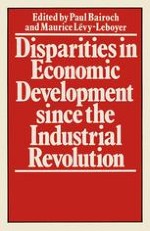
1981 | OriginalPaper | Chapter
Egypt, Iran and Turkey, 1800–1970: Patterns of Growth and Development
Author : Charles Issawi
Published in: Disparities in Economic Development since the Industrial Revolution
Publisher: Palgrave Macmillan UK
Included in: Professional Book Archive
Activate our intelligent search to find suitable subject content or patents.
Select sections of text to find matching patents with Artificial Intelligence. powered by
Select sections of text to find additional relevant content using AI-assisted search. powered by
An assessment of the relative economic performance of Egypt, Iran and Turkey1 from 1800 to 1970 is more meaningful than most such comparisons. Throughout the period, the three countries have had populations of much the same size and degree of development, and around 1800 their per capita incomes must have been roughly equal and their economic structures basically similar. Until the Oil Revolution of 1970–73, which drastically changed their relative positions, there was no significant difference in their resource endowments. All three share a common historical and cultural legacy: each had originated one of the major ancient civilisations, each had greatly contributed to the formation of Islamic society and culture, and all three had experienced the stagnation and decline that characterised the Middle East in the modern period. Lastly, all three were integrated in the world economy at much the same time and subjected to the same major forces: the thrust of European imperialism, the expansion of world trade, the spread of mechanical transport and electric communications, the flow of vast amounts of foreign capital, the unsettling Western ideas of nationalism, secularism and political liberty, and the influx of hundreds and thousands of Europeans with the technical, business or administrative skills required for the modernisation of society which the Middle Eastern governments were, with various degrees of commitment and success, attempting to carry out.